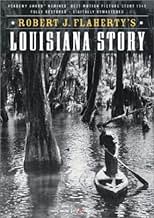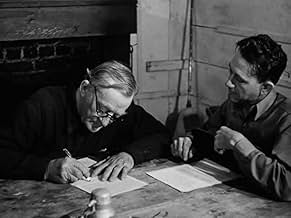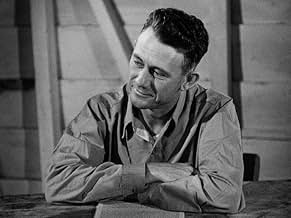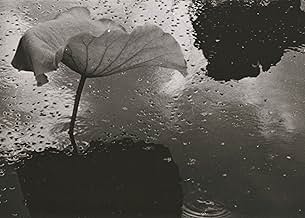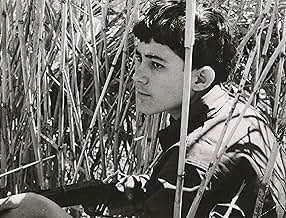IMDb-BEWERTUNG
6,4/10
2295
IHRE BEWERTUNG
Füge eine Handlung in deiner Sprache hinzuThe idyllic life of a young Cajun boy and his pet raccoon is disrupted when the tranquility of the bayou is broken by an oil well drilling near his home.The idyllic life of a young Cajun boy and his pet raccoon is disrupted when the tranquility of the bayou is broken by an oil well drilling near his home.The idyllic life of a young Cajun boy and his pet raccoon is disrupted when the tranquility of the bayou is broken by an oil well drilling near his home.
- Regie
- Drehbuch
- Hauptbesetzung
- Für 1 Oscar nominiert
- 4 Gewinne & 3 Nominierungen insgesamt
Empfohlene Bewertungen
10Huron
Robert Flaherty had a great eye for the interesting shots. Never more so than this oil company funded film about a young boy seeing the oil rig come to his Louisiana bayou. Although there is not much of a story the shots of the oil rig, life in the bayou, and the moods that Flaherty captures make it a film well worth seeing. If you see "Man of Aran" or "Nannok of the North" remember it was the same great documentary filmmaker. I've seen it twice and probably will see it again someday.
A Cajun boy is fishing and hunting with his pet raccoon out in the Louisiana bayou. He comes upon a crew of oil drillers and has various adventures.
This was Oscar nominated for writing which is probably the least compelling part of this movie. It can be argued that there is barely any writing involved. Its strength is the sense of reality in the swamp and the oiler crew. It's a slice of life. It's the docu-style of filmmaking. The kid may not be a great actor but he has realism on his side. There are some great scenes. I can't forget the raccoon and it's great to see a real drilling crew working. The plot isn't much. It's really just a series of swamp adventures.
This was Oscar nominated for writing which is probably the least compelling part of this movie. It can be argued that there is barely any writing involved. Its strength is the sense of reality in the swamp and the oiler crew. It's a slice of life. It's the docu-style of filmmaking. The kid may not be a great actor but he has realism on his side. There are some great scenes. I can't forget the raccoon and it's great to see a real drilling crew working. The plot isn't much. It's really just a series of swamp adventures.
10tavm
Under the heading "Louisiana" I checked this documentary called Louisiana Story by Robert J. Flaherty out of curiosity from my local East Baton Rouge Parish Library. Beautiful views of the state swamps as well as fascinating scenes of the oil rig that inhabits them dominates the film which depicts the adventures of a Cajun boy on a boat fishing and hunting alligators with his pet raccoon. His father occasionally comes along for the ride and they both have friendly relations with the workers of the oil well. There are some scenes of the mother as well. Great Pulitzer Prize-winning music scored by Virgil Thomson is beautifully performed by The Philadelphia Symphony Orchestra as conducted by Eugene Ormandy. Wonderful cinematography by Richard Leacock. Worth checking out as a depiction of late '40s Louisiana as well as the final film of Mr. Flaherty before his death in 1951. Update-4/29/07: The Cajun boy that starred in this film, J.C. Boudreaux, is now 73 and lives with his wife of 55 years, Regina, in a FEMA trailer in the town of Sweet Lake which is south of Lake Charles. They moved there after Hurricane Rita destroyed their home in Cameron. They had seven children who have provided them numerous grand-and great-grandchildren. Boudreaux still loves fishing. I found this out reading this morning's The (Baton Rouge) Advocate.
10bandw
If you appreciate black and white cinematography, then you will delight in seeing the restored version of this movie on DVD. Cinematographer Richard Leacock and director Flaherty have teamed up to be the Ansel Adams of the film world. This is one of the most cinematic of films - its power and magic lie in the poetry of the images. The score by Virgil Thomson deserved its Pulitzer Prize for music in 1949; it receives a first class performance here by the Philadelphia Orchestra under Eugene Ormandy.
Some have commented on the weak story, but I rather enjoyed it - it could be billed as "Huckleberry Finn meets Standard Oil." The story is told through the eyes of a young Cajun who lives with his grandfather and mother in a simple cabin in the Louisiana marshland. In the opening shots we see the boy exploring the bayous in his canoe with his pet raccoon. He has an elemental bond with his natural environment that made me jealous. The boy's grandfather signs a lease allowing Humble Oil to drill a wildcat well on the bayou near his cabin. We share the boy's wonder at seeing the oil derrick being floated into position and his excitement in being invited onto the rig to follow the drilling up close.
From the viewpoint of a more environmentally conscious time some sixty years later, the benevolent portrayal of the oil industry seems a bit quaint, but that a young boy should be fascinated by the process seems genuine, in any era. In fact I found the details on the drilling captivating, particularly the way those scenes were filmed as a ballet with the roustabouts moving to the rhythms of their work accompanied by the clanking of pipes and chugging of engines.
I had a problem with how delighted the grandfather and mother were at being able just to buy a few gifts from the profits of oil having been struck on their land. While the company to whom they had leased their land was making mucho bucks, it looks like the family got a few hundred dollars. Given the fact that this movie was commissioned by Standard Oil, I am sure that it was not the intent to make the company appear so greedy, but maybe that's one thing that hasn't changed in sixty years.
Joseph Boudreaux as the young boy is endearing and Lionel Le Blanc is believable as the crusty grandfather. All the actors appear to be locals - this adds authenticity, but also presents a problem in that they are not greatly skilled when it comes to delivering their lines. But there is minimal dialog and what there is is hardly necessary as the music and images carry you along.
The DVD has several interesting extras, one of them being a reading of some letters from Richard Leacock (postmarked from Abbeville, Louisiana) to his wife during the long filming. In one letter he says that they ran across the twelve-year-old Boudreaux in a café in Cameron, Louisiana. He had an Acadian accent, had trapped with his father, could handle a Cajun pirogue, and had an infectious smile. They figured he was perfect for the part but, since he was born out of wedlock and under-aged, there were significant difficulties under Louisiana law to be worked out before he could be signed on. Leacock's letters are quite frank. In one he notes that there was buzz about the visit from the director of all Standard Oil public relations and that Flaherty did not like him, referring to him as "the old bastard."
This is a wonderful film in the literal sense of the word wonderful.
Some have commented on the weak story, but I rather enjoyed it - it could be billed as "Huckleberry Finn meets Standard Oil." The story is told through the eyes of a young Cajun who lives with his grandfather and mother in a simple cabin in the Louisiana marshland. In the opening shots we see the boy exploring the bayous in his canoe with his pet raccoon. He has an elemental bond with his natural environment that made me jealous. The boy's grandfather signs a lease allowing Humble Oil to drill a wildcat well on the bayou near his cabin. We share the boy's wonder at seeing the oil derrick being floated into position and his excitement in being invited onto the rig to follow the drilling up close.
From the viewpoint of a more environmentally conscious time some sixty years later, the benevolent portrayal of the oil industry seems a bit quaint, but that a young boy should be fascinated by the process seems genuine, in any era. In fact I found the details on the drilling captivating, particularly the way those scenes were filmed as a ballet with the roustabouts moving to the rhythms of their work accompanied by the clanking of pipes and chugging of engines.
I had a problem with how delighted the grandfather and mother were at being able just to buy a few gifts from the profits of oil having been struck on their land. While the company to whom they had leased their land was making mucho bucks, it looks like the family got a few hundred dollars. Given the fact that this movie was commissioned by Standard Oil, I am sure that it was not the intent to make the company appear so greedy, but maybe that's one thing that hasn't changed in sixty years.
Joseph Boudreaux as the young boy is endearing and Lionel Le Blanc is believable as the crusty grandfather. All the actors appear to be locals - this adds authenticity, but also presents a problem in that they are not greatly skilled when it comes to delivering their lines. But there is minimal dialog and what there is is hardly necessary as the music and images carry you along.
The DVD has several interesting extras, one of them being a reading of some letters from Richard Leacock (postmarked from Abbeville, Louisiana) to his wife during the long filming. In one letter he says that they ran across the twelve-year-old Boudreaux in a café in Cameron, Louisiana. He had an Acadian accent, had trapped with his father, could handle a Cajun pirogue, and had an infectious smile. They figured he was perfect for the part but, since he was born out of wedlock and under-aged, there were significant difficulties under Louisiana law to be worked out before he could be signed on. Leacock's letters are quite frank. In one he notes that there was buzz about the visit from the director of all Standard Oil public relations and that Flaherty did not like him, referring to him as "the old bastard."
This is a wonderful film in the literal sense of the word wonderful.
This is a classic film that blurs the line between documentary and fiction. Here, you won't find a very good plot, but some very interesting sequences and some of the most visually pleasing imagery ever put to screen.
From watching both this and "Man of Aran" you can tell that Flaherty is a very unconventional filmmaker. His films have staged scenes that, as I mentioned earlier, blur the line between fiction and nonfiction creating a nontraditional signature style.
In this film, we follow a young boy (and his friend, a raccoon) living an average life in his hometown. We see him paddle down rivers, walk through the woods, and have tons of entertaining adventures. Then, a bunch of oil drillers move to town. We watch these oil drillers do their work with very minimal dialogue. It's almost all expressed in visuals.
While the film may sound boring and seems to start off kind of boring, in the end, it's a truly adventurous masterpiece! One of my favorites!
From watching both this and "Man of Aran" you can tell that Flaherty is a very unconventional filmmaker. His films have staged scenes that, as I mentioned earlier, blur the line between fiction and nonfiction creating a nontraditional signature style.
In this film, we follow a young boy (and his friend, a raccoon) living an average life in his hometown. We see him paddle down rivers, walk through the woods, and have tons of entertaining adventures. Then, a bunch of oil drillers move to town. We watch these oil drillers do their work with very minimal dialogue. It's almost all expressed in visuals.
While the film may sound boring and seems to start off kind of boring, in the end, it's a truly adventurous masterpiece! One of my favorites!
Wusstest du schon
- WissenswertesStandard Oil of New Jersey (became Exxon in 1972 and Exxon/Mobil in 1999) contributed $258,000 to the film's production. Although the company had no rights and no identification in the film, it stood "to get across the idea that oil companies are beneficently public-spirited, their employees honest, industrious and amiable, and their operations productive and innocuous." According to a modern source, Robert J. Flaherty's contract with Standard Oil insured that all of the film's profits went to him. The only connection was that Humble Derrick No. 1 is mentioned - and the Humble Oil Co. was 50% owned by Standard Oil of New Jersey at the time.
- PatzerIn the opening sequence, when The Boy first spots the raccoon, his hair is neat. Then it's mussed. Then it's neat again.
- VerbindungenFeatured in Studies for Louisiana Story (1965)
Top-Auswahl
Melde dich zum Bewerten an und greife auf die Watchlist für personalisierte Empfehlungen zu.
- How long is Louisiana Story?Powered by Alexa
Details
Box Office
- Budget
- 258.000 $ (geschätzt)
- Laufzeit
- 1 Std. 18 Min.(78 min)
- Farbe
- Seitenverhältnis
- 1.37 : 1
Zu dieser Seite beitragen
Bearbeitung vorschlagen oder fehlenden Inhalt hinzufügen

